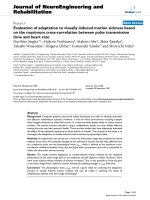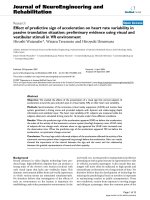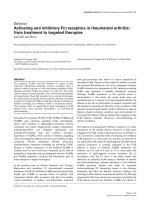Assessment and quantification of foetal electrocardiography and heart rate variability of normal foetuses from early to late gestational periods 2
Bạn đang xem bản rút gọn của tài liệu. Xem và tải ngay bản đầy đủ của tài liệu tại đây (3.17 MB, 48 trang )
Materials and methods
80
CHAPTER 6
MATERIALS AND METHODS
Materials and methods
81
1 Patient selection
1.1 Study subjects
This is a longitudinal study whereby serial electrocardiograms (ECG) from a
cohort of 100 healthy foetuses were measured from 18 to 41 weeks of gestation. The
women who participated in this study had singleton pregnancies and gave informed
consent. They were recruited at about 18 weeks of pregnancy from an antenatal clinic
at the National University Hospital. Foetal ECG (fECG) recordings were monitored at
the first visit and at each subsequent antenatal visit to the clinic until the final visit
before delivery. The interval between antenatal visits ranged from one to four weeks
depending on the stage of the pregnancy.
1.2 Exclusion criteria
Women whose foetuses exhibited arrhythmia, IUGR (intrauterine growth
restriction), congenital heart disease, or in whom maternal hypertension, diabetes or
SLE (Systemic Lupus Erythematosus) was present, were excluded from the study.
1.3 Patient withdrawal
Initially, 115 pregnant women were recruited progressively. After the
exclusion of those with the above-mentioned conditions, 100 women were left to
participate in the study. Out of these 100 remaining participants, nine did not
complete the study due to reasons such as delivery in another hospital or country and
foetal loss. In addition, 23 women refused monitoring on at least one follow-up visit
due to personal reasons.
Materials and methods
82
2 Methodology
2.1 Foetal ECG acquisition procedures
The fECG was recorded using a non-invasive system by attaching three
cutaneous electrodes on the maternal abdominal surface. The three electrodes are
namely, one designated reference electrode (black) and two other recording
electrodes (red), one of which is positive and the other negative. The three disposable
electrodes (3M Red Dot 2237) for recording fECG were placed in an equilateral
triangle formation on the maternal abdomen – one electrode each at the right and left
hypochondriac area and one electrode just above the symphysis pubis (Figure 6-1).
The reference electrode was placed either at the right or left hypochondriac area while
the recording electrodes are placed on the two remaining sites. The location of the
reference electrode was determined based on the quality of the signal. All three
electrodes were connected to a single channel digital recorder (patient unit) with a
sampling rate of 300 Hz (Figure 6-2). The patient unit was connected via a fiber optic
data link to the computer that operated the FEMO system software. The whole set-up
is illustrated in Figure 6-3.
To reduce skin impedance, the three areas of skin contact were gently abraded
to remove dead surface skin cells. After electrode placement, a skinprep analyzer
(Union skinprep 3211D) was used to ensure that the electrode impedance was below
the recommended 5 kΩ. The women were rested in a semi-recumbent position for at
least 5 minutes prior to the actual fECG recording, which lasted for 10 minutes. All
recording sessions took place between 0900 hrs and 1700 hrs.
Materials and methods 83
Electrode Navel
Figure 6-1: Electrode placement for abdominal fECG recording
Materials and methods 84
Figure 6-2: Patient unit of FEMO system and 3 recording electrodes
Materials and methods 85
Figure 6-3: Setup of FEMO system
Materials and methods
86
2.2 Foetal ECG equipment description and operation
The abdominal fECG was measured and processed instantaneously by a
specifically-designed computerized system, FEMO (Medco Electronic Systems Ltd.,
Israel). FEMO system is an advanced, non-invasive device that detects the
superimposed foetal and maternal ECG (mECG) signals from the maternal abdomen,
then separates and processes the two signals. It operates in real-time (delay not longer
than 0.06 seconds), displaying the true beat-to-beat foetal heart rate and the averaged
fECG complex.
In abdominal ECG processing, the single most important problem is the
subtraction of the mECG template from the combined foetal-maternal ECG signals
obtained from the abdominal recording. This subtraction is most vulnerable to
computational errors and must be performed at the precise moment. Otherwise, the
residual value of the maternal contribution will be larger than the foetal contribution.
The core of the FEMO fECG detection algorithm (patented) is based on cancellation
of the maternal contribution in both the first and second derivatives of the abdominal
signal. In contrast to other cancellation procedures, which are generally performed in
the abdominal ECG signal itself. The processing of the two foetal-maternal
derivatives as two independent parallel data channels reduces computational errors
arising from subtraction of the maternal signals. This is because these errors are
unlikely to occur simultaneously in both channels. Thus the double computation and
the combination of the resulting functions reduce the number of detection errors,
thereby successfully producing accurate fECG signals without any maternal
Materials and methods
87
contribution. In addition, the two derivatives also eliminate the influence of baseline
drift, and the derivation procedure provides additional filtering to differentiate the
maternal and foetal ECG.
A low pass filter with a cut-off frequency of 25 Hz provided an output
containing pure maternal signals, while a 110 Hz low pass filter transferred both
maternal and foetal signals. The first derivative was then computed by recursive
integration. The second derivative was calculated directly by an approximation based
on the undetermined coefficients (Lagrange) interpolation method. The exact
locations of maternal R waves were determined by a local fine adjustment procedure,
and the mECG template M was constructed. After separately subtracting M from the
1
st
and 2
nd
derivatives, the results were summed into a combined signal from which
the foetal complexes were detected after undergoing a smoothing procedure. A
simplified flow chart of the algorithm is shown in Figure 6-4.
The reliability and accuracy of the FEMO system has been tested against the
‘gold standard’ scalp electrode fECG measured during labour. Excellent agreement is
obtained both in foetal heart rate (Figure 6-5a) and in the foetal ECG morphology
(Figure 6-5b), with a correlation of 0.9 and significance of p<0.001 (Karin J et al,
1994).
Materials and methods 88
Integration
Subtraction of
maternal contribution, M
Raw abdominal ECG data
A/D
Low pass filter 110 HzLow pass filter 25 Hz
M MF’’ MF’
F’’ F’
Calculate
maternal RR
interval series
Calculate
average foetal
ECG complex
Calculate
foetal RR
interval series
Summation of 1
s
t
and 2
nd
derivatives
Figure 6-4: Block diagram of R wave detection algorithm in FEMO software
A/D- Analogue to digital converter; M- maternal ECG signal; MF’ and MF’’- 1
st
and
2
nd
derivatives containing both maternal and foetal ECG signals; F’ and F’’- Foetal
ECG signals after subtraction of M from MF’ and MF’’
Materials and methods 89
Figure 6-5a: Comparison of foetal heart rate recorded by direct (scalp) and
abdominal (FEMO) electrodes.
Materials and methods 90
Figure 6-5b: Comparison of foetal ECG complex recorded by direct (scalp) and
abdominal (FEMO) electrodes.
Materials and methods
91
2.3 Measurement of foetal ECG parameters
Figure 6-6 shows an example of the raw abdominal ECG strip comprising of
both maternal and foetal ECG complexes, the online display of foetal and maternal
heart rates, as well as the average foetal ECG complex, indicating the onset and
termination points used in the measurement of the various cardiac time intervals.
These points were visually determined as the earliest observed deflection from the
isoelectric line (onset) and the latest observed return of the ECG signal to the
isoelectric line (termination). The durations of the cardiac intervals were then
determined from the averaged fECG signal.
For analysis, each 10-minute recording of fECG was divided into 4 equal
periods of about 2.5 minutes (approximately >300 beats) whereby an average fECG
complex was generated for each period. From each averaged fECG complex, cardiac
time intervals of the P wave duration (P
o
to P
t
), PR interval (P
o
to Q
o
), QRS complex
(Q
o
to S
t
), QT interval (Q
o
to T
t
), and T wave duration (T
o
to T
t
) were determined.
Each fECG recording yielded 4 sets of the above time intervals, from which their
mean values were calculated. Since the QT interval is known to be dependent on the
heart rate, the QT intervals were corrected for heart rate (QTc) according to Bazett’s
formula (QTc = QT/√RR).
In a separate cohort of 197 foetuses, intrapartum fECG was performed in the
labour ward during the 1
st
stage of labour. The recording equipment and protocol
were the same as those used in the antenatal fECG recordings except that the fECG
Materials and methods 92
(a) Raw abdominal ECG
M
M
M
M
M
F
F
F
F
F
F
F
F
F
(b)
Foetal
Maternal
(c) Average fECG
P
o
P
t
Q
o
S
t
T
o
T
t
Figure 6-6: (a) Raw abdominal ECG strip, (b) foetal and maternal heart rate
traces, and (c) averaged foetal ECG complex recorded by FEMO.
M= maternal QRS complex; F= foetal QRS complex;
Subscripts o and t = onset and termination points of P, QRS and T waves.
Materials and methods
93
recording was performed only once (during labour) on each patient. Similar to
antenatal fECG, each recording of intrapartum fECG was performed for 10 minutes.
In addition to the above cardiac time intervals, the T/QRS ratio and conduction index
were also computed for this group of foetuses. T/QRS ratio was calculated by
dividing the T wave amplitude by the QRS peak-to-peak amplitude whereas the
conduction index was computed as the Pearson’s correlation coefficient of the PR
interval with the fHR.
2.4 Neonatal ECG acquisition and measurement
For the mothers who gave written consent, a standard resting 12-lead ECG
was recorded for each neonate one to two days post-partum using ECG equipment
MAC5000 (Marquette GE Medical Systems Information Technologies, Milwaukee,
Wisconsin, USA). The ECG was recorded with the neonate in a supine resting
position, using a paper speed of 25 mm/s. The neonatal ECG parameters measured by
MAC5000 were the durations of PR interval, QRS interval, QT interval and QTc
interval.
The reason for measuring neonatal ECG was to compare the
electrocardiographic changes in the ECG before and after birth. Nevertheless it is to
be noted that equipment used for recording foetal and neonatal ECG were different.
Intra- and extra-uterine conditions were also not similar.
Materials and methods
94
2.5 Foetal HRV measurement
For analysis of foetal HRV, a computer system (F-EXTRACT) was developed
in collaboration with the Computer Science Department of National University of
Singapore. This HRV program was developed using MatLab 6.1 (Release 12.1) and
requires MatLab installation to run. A more detailed description of F-EXTRACT is
discussed in Chapter 9.
From the foetal ECG signals, the RR-intervals were extracted for HRV
analysis. Using F-EXTRACT, foetal HRV was determined in both time and
frequency domains. The time domain indices measured were the mean foetal heart
rate, mean RR interval, SDNN, rMSSD and pNN27. Mean heart rate is the mean
foetal heart rate measured in beats per minute. The mean RR interval is the average
duration of all the RR intervals during the recording. It is also known as mean NN
interval (mNN), indicating normal-to-normal intervals, i.e., between beats in sinus
rhythm.
SDNN is the standard deviation of NN interval and is defined as:
where NN
i
is the duration of the i-th NN interval, n is the number of all NN intervals
and m is their mean duration. Since variance (square of standard deviation) is
mathematically equal to total power of spectral analysis,
SDNN reflects total HRV,
i.e., all the cyclic components responsible for heart rate variation during the period of
recording, such as respiratory, baroreceptor, thermoregulation, etc.
Materials and methods
95
Another time domain index measured is the rMSSD, which is the root mean
square of successive differences between adjacent NN intervals, mathematically
defined as:
where NN
i
is the duration of the i-th NN interval and n is the number of all NN
intervals.
Finally, pNN27 is another time domain index measured in this study. It is
defined as the percentage of the number of pairs of adjacent NN intervals differing by
more than 27 ms in the entire recording divided by the total number of all NN
intervals. This index is a modified version of the more familiar pNN50, which is
defined as the percentage of the number of pairs of adjacent NN intervals differing by
more than 50 ms in the entire recording (NN50) divided by the total number of all NN
intervals. The absolute threshold of 50 ms in the pNN50 index makes it dependent on
the underlying heart rate. A lower heart rate (longer RR intervals) has a higher chance
of adjacent intervals differing by more than 50 ms than a higher heart rate (shorter RR
intervals). Hence a proportional threshold of 6.25% of the mean RR interval has been
proposed (Mietus JE et al., 2002; Malik M, 1997; Ewing DJ et al., 1984). This
corresponds to a 50 ms difference at the adult heart rate of 75 beats per minute (bpm).
However, the average heart rate of the fetus is almost twice that of the adult’s, with
the average being 140 bpm. Thus, using the threshold of 6.25%, a pNN27 would be
more suitable for performing HRV calculation in the fetus.
Materials and methods
96
As for HRV analysis in the frequency-domain, the first step was to produce a
foetal tachogram for each fECG recording, whereby mean NN intervals were plotted
against their beat number. Next, a 256-second of artifact-free segment was selected
from the tachogram for generating the foetal HRV power spectrum, which was based
on the Fast Fourier Transformation (FFT). The area under each power spectrum was
then calculated for three regions: very low frequency (VLF: 0.003-0.04 Hz), low
frequency (LF: 0.04-0.15 Hz) and high frequency (HF: 0.15-1.0 Hz). Other calculated
frequency-domain parameters included the total spectral power, normalized LF and
HF power, as well as LF/HF ratio. Total power refers to the total power in the HRV
spectrogram. The LF/HF ratio was computed by dividing the HF power by LF power,
while normalized LF and HF power were calculated by the following formulae:
Normalized LF = LF/(TP-VLF) x100
Normalized HF = HF/(TP-VLF) x100
2.6 Comparison of F-EXTRACT and Nevrokard HRV softwares
The HRV measurements derived from the F-EXTRACT was compared to
those derived from a commercial HRV software, the Nevrokard
HRV System
(Medistar Inc., Slovenia). Both HRV systems were utilized to perform the same set of
calculations on the same time epochs of foetal RR-interval samples. Bland-Altman
analysis (Bland JM and Altman DG, 2003) was used to evaluate the level of
agreement between the two programs.
Materials and methods
97
2.7 Correction of aberrant beats
Since HRV is derived from the measurement of heart cycle period or R-R
interval, a missing beat will result in a longer than normal R-R interval. Similarly, an
ectopic beat (often premature) will produce a short R-R interval followed by a
compensatory delay, and hence a prolonged interval. For this reason, ectopic or
missing beats introduce significant errors in the HRV statistics and distort the HRV
spectrum, thereby making it difficult to evaluate a patient’s neurocardiac control
through HRV techniques (Berntson GG et al., 1998). Therefore, these aberrant beats
must be excluded from the HRV calculation. F-EXTRACT enables the automatic
detection and exclusion of any abnormal beats or artifacts before running FFT to
construct the power spectral plots. QRS complexes classified as noise or ectopic beats
were excluded. Only normal-to-normal intervals (in sinus rhythm) were used in the
calculation of HRV.
2.8 Statistics
Statistical analyses were performed using SPSS 12.0 for Windows (SPSS Inc.,
Chicago, IL, USA). The results were expressed as mean ± SD. Statistical significance
was assumed at a level of p < 0.05. Statistical analyses of independent samples t-tests,
one-way ANOVA and linear regression were performed using SPSS 12.0 for
Windows, while Bland-Altman analyses were performed using Prism 4.03 for
Windows (GraphPad Software Inc., San Diego, CA, USA).
ECG of healthy foetuses
98
CHAPTER 7
CARDIAC TIME INTERVALS
OF HEALTHY FOETUSES
ECG of healthy foetuses
99
1 Introduction
As in the adult, the foetal electrocardiogram (fECG) provides
important information about the foetal cardiac electrical activity. Foetal cardiac time
intervals may be useful for the diagnosis of arrhythmias (Abe K et al., 2005; Sturm R
et al., 2004; Yumoto Y et al., 2004), heart blocks (Lin MT et al., 1998; Mohajer MP
et al., 1995), long QT syndrome, (Schneider U et al., 2005; Hosono T et al., 2002;
Menéndez T et al., 2000; Hamada H et al., 1999), intra-uterine growth restriction
(IUGR) (Grimm B et al., 2003; van Leeuwen P et al., 2001; Pardi G et al., 1986) and
foetal hypoxaemia (Rosen KG, 2005; Reed NN et al., 1996; Mohajer MP et al.,
1994).
In 1986, Murray (Murray HG, 1986) observed that the conduction index
(Pearson’s correlation coefficient of the PR interval with foetal heart rate (fHR)),
which was normally negative, became positive during foetal acidosis. Subsequent
studies demonstrated the effectiveness of the use of conduction index in the reduction
of foetal acidosis as well as unnecessary foetal blood sampling and instrumental
deliveries (Reed NN et al., 1996; van Wijngaarden WJ et al., 1996b).
Other fECG studies showed that the ST waveform reflects the metabolic
events occurring at a tissue level in response to compensatory mechanisms for oxygen
lack in a vital central organ. A progressive rise of the foetal ST waveform quantified
by T/QRS ratio indicates prolonged myocardial stress and a switch to anaerobic
metabolism
(Rosen KG and Luzietti R, 1994; Rosen KG and Lindecrantz K, 1989;
ECG of healthy foetuses
100
Jenkins et al., 1986; Rosen KG, 1986a; Lilja et al., 1985; Rosen KG et al, 1976;
Rosen KG et al., 1975).
Based on these findings, the STAN foetal monitor (ST Analyser, Cinventa
AB, Sweden) has been developed to evaluate intrapartum fECG in terms of the ST
segment and the T wave using foetal scalp electrodes. The addition of ST monitoring
to standard fHR monitoring has shown to be useful in predicting fetal acidosis (Amer-
Wahlin I et al., 2002), improving the clinical decision making for obstetric
interventions (Amer-Wahlin I et al., 2005; Kwee A et al., 2004; Ross MG et al.,
2004), thereby improving perinatal outcome (Rosen KG, 2005; Olofsson P, 2003).
Instead of using scalp electrodes, fECG can be non-invasively obtained using
electrodes placed on the maternal abdomen. However, despite the usefulness of fECG
and the observations of configuration changes in abdominal fECG in relation to foetal
hypoxia, problems of electrical noise and signal distortion have restricted its
application for routine clinical monitoring of hypoxia in the human foetus.
The main problem in measuring abdominal fECG is the poor signal-to-noise
ratio. Foetal ECG is often superimposed and hidden by maternal ECG (mECG),
which is many times higher in intensity than fECG (Peters M et al., 2001). Maternal
electromuscular activity, external electrical interferences (50 Hz noise), and the
intrinsic noise of the equipment also contribute to the low signal-to-noise ratio. In
order to obtain clear abdominally-derived fECG from which diagnostic parameters
ECG of healthy foetuses
101
can be derived, the main aim is to remove the various contributions to noise that may
mask the low fECG signal.
Advances in signal recognition and separation now allows fECG to be isolated
from the mECG. Sophisticated filtering, processing and amplification techniques are
used to yield clear fECG complexes containing P, QRS and T waves. The aim of this
research is to utilize a new equipment, FEMO (Medco Electronic Systems Ltd.,
Israel), which uses a non-invasive abdominal technique to measure foetal cardiac time
intervals in normal singleton pregnancies.
In order to discriminate between normal and pathological changes in the
fECG, a database of normal values of cardiac time intervals for reference is essential.
Serial fECGs from a cohort of 100 healthy foetuses were measured from 18 to 41
weeks of gestation. To the best of my knowledge, no known longitudinal follow-up
studies of fECG cardiac time intervals obtained from abdominal fECG have been
described in the literature. The data in this study will contribute to the understanding
of normal cardiac time intervals in foetuses at various gestational ages.
2 Study population
The study population consisted of 100 women with singleton pregnancies with
no clinical maternal or foetal complications. The women were aged between 22 and
41 years (mean ± SD: 31.8 ± 3.8 years). The foetuses were divided into 5 groups
ECG of healthy foetuses
102
according to gestational age (GA). These groups were: 18-22, >22-27, >27-32, >32-
<37, and ≥ 37 weeks.
The basis of dividing the foetuses into the various GA is as follows: the first
group of 18-22 weeks describes the non-viable age for foetuses (Macfarlane PI et al.,
2003; Allen MC et al., 1993; Nicholl MC et al., 1991). Sometimes called “micro-
premies”, foetuses born during >22-27 weeks are regarded as extremely preterm. The
early neonatal mortality is high, with up to 50% of severe disability occurring in those
born before 26 weeks (Molholm HB et al., 2002; Wood NS et al., 2000). Their
chances of survival vary significantly depending on multiple factors such as foetal
age, weight and gender, steroid/surfactant treatment, mode of presentation, multiple
pregnancy, etc. (Effer SB et al., 2002; El-Metwally D et al., 2000; Battin M et al.,
1998; Kramer WB et al., 1997; Lefebvre F et al., 1996; Whyte HE et al., 1993).
According to the World Health Organization, an infant born before the 37th
week of gestation is defined as preterm (WHO, 1993). Hence the 5
th
group of foetuses
aged ≥ 37 weeks constitutes term foetuses. Moderate prematurity refers to foetuses of
>32-<37 weeks of gestational age. Foetuses born between >27-32 weeks are
considered as very preterm (Surkan PJ et al., 2004; Moutquin JM et al., 2003).
ECG of healthy foetuses
103
3 Method
Foetal ECG recording was performed on all the 100 foetuses for 10 minutes
during each visit. Average cardiac time intervals of the P wave duration, PR interval,
QRS complex, QT interval, QTc interval and T wave duration were determined.
Intrapartum fECG recording was performed on a separate cohort of 197
foetuses during the 1
st
stage of labour. The recording protocol was similar to that used
for antenatal fECG. Measurements included the above cardiac time intervals, as well
as the T/QRS ratio and conduction index.
Neonatal ECG recording was performed on a subset (n=51) of the cohort of
100 foetuses at 1-2 days after delivery using a standard resting 12-lead ECG. The
cardiac time intervals obtained from the neonatal ECG results include the PR interval,
QRS duration, QT interval and QTc interval. A detailed description of the above
methods can be found in Chapter 6.
4 Results
4.1 Success rates of foetal ECG recording
The success rates of detecting the various cardiac waveforms on the fECG are
displayed in Table 7-1. On the whole, the QRS complex was successfully measured
in 92.1% of the recordings, while P and T waves were recognized in 76.8% and
81.0% of all recordings, respectively. The PR and QT intervals had success rates
similar to P and T waves, respectively. Success rates were generally poorer during the
ECG of healthy foetuses
104
Table 7-1 - Percentage of successful fECG waveform measured in foetuses
(n=100) during various gestational stages
GA (weeks) N P wave PR interval QRS QT interval T wave
18-22
91 79.1 (72) 78.0 (71) 96.7 (88) 82.4 (75) 80.2 (73)
>22-27
65 76.9 (50) 76.9 (50) 90.8 (59) 70.8 (46) 70.8 (46)
>27-32
61 54.1 (33) 54.1 (33) 80.3 (49) 72.1 (44) 68.9 (42)
>32-<37
78 73.1 (57) 73.1 (57) 91.0 (71) 84.6 (66) 84.6 (66)
>=37
111 90.1 (100) 90.1 (100) 96.4 (107) 91.9 (102) 91.9 (102)
Total 406 76.8 (312) 76.6 (311) 92.1 (374) 82.0 (333) 81.0 (329)
GA- Gestational age
fECG- Foetal ECG
Values are presented as p (n) where
p- percentage of successful fECG waveform measured and
n- number of fECG recordings where fECG waveform was successfully measured.
Success rates are calculated by (n/N x100) where N is the total number of fECG
recorded at each gestational stage.









